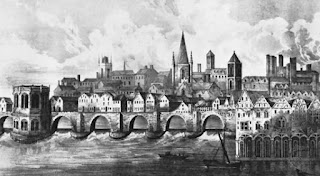Living Bridges: The Inhabited Bridge: Past, Present and Future
edited by Peter Murray and MaryAnne Stevens.
Published by Royal Academy of Arts, London in 1996
ISBN: 3-7913-1734-2
(Amazon)
Read by the author in 2021
When determining the ritual extents of a city, the Mishnah sets the boundary based on the furthest inhabited dwelling. In this context, it rules that "bridges and and burial monuments that have in them a residence" are counted as dwellings. (Mishnah Eruvin 5:1, Tosefta Eruvin 4:7)
וּגְשָׁרִים וּנְפָשׁוֹת, שֶׁיֵּשׁ בָּהֶן בֵּית דִּירָה
Both Rashi and Tosefot clarify the reference to residences in burial monuments, but neither commentary feels any pressing need to explain residences on a bridge. (Babylonian Talmud Eruvin 53a) This is because although inhabited bridges were exceptional enough to warrant a specific mention in the Mishnah, they were nonetheless quite ordinary and were part of the urban landscape in medieval Europe.
The book Living Bridges was produced as part of an exhibition in 1996 stages by the Royal Academy of Arts in London. It focuses on medieval European inhabited bridges. An interview with Jean Dethier tries to situate the inhabited bridge as a specifically medieval European building type (p.24). However, we see from rabbinic literature that the phenomenon dates back to antiquity. This is also evident from another book I hope to highlight in the future, Colin O'Connor's Roman Bridges (Cambridge: Cambridge University Press, 1993) which surveys Roman bridges and even has a picture of an inhabited bridge, the Ponte d'Augusto at Narni, on its frontispiece. Photographs of other examples, Puente del Diablo at Mortorell, Spain and Ponte di Cecco at Ascoli Piceno, appear later in that book (p.102, 168).
Living Bridges hints at several reasons for building on bridges: space constraints inside walled cities, a need to defend the bridges, access to running water for powering mills, and an advantage at waste disposal. (p.16) O'Connor, for his part, writes that bridges were considered both physically dangerous and metaphysically treacherous, as they subverted and challenged the spirits of the river. This prompted some bridge builders to construct shrines upon them. This sentiment is perhaps reflected in R. Shimon ben Lakish's assertion that "men are judged when they cross bridges" (Babylonian Talmud, Shabbat 32a). Samuel Krauss adds that bridges often had toll booths. (Qadmoniyot Hatalmud I/1 162, quoting our same Mishnah and Tosefta)
Living Bridges includes a number of essays, though the highlight is the nice collection of engravings and models of inhabited bridges: London Bridge, Old Tyne Bridge, Ponte alle Grazie, Newcastle Bridge, the Krämerbrücke in Erfurt, and many more. These examples are helpfully arranged by century and location. The book gets a bit weirder as it shifts to the twentieth century, unbuilt and fanciful designs, and speculation toward the future as part of a contest that accompanied the exhibition.
 |
Old London Bridge, lithograph after a manuscript illumination c. 1500 in the British Library (Royal M.S.S. 16 Fii.XVJ) (Taken from britannica.com)
To learn more on the subject, consult ArchitecTorah p. 109 (Bridges and Fords) and p. 304 (Building on Pilotis)

Comments
Post a Comment